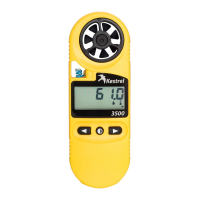Kestrel® 3500 Pocket Weather® Meter 7
Altitude and Barometric Pressure - the Kestrel 3500 will measure station pressure in order
to calculate barometric pressure and altitude. Changes in either air pressure or altitude will
aect these readings, so it’s important to make adjustments as necessary.
ABOUT BAROMETRIC PRESSURE AND ALTITUDE ADJUSTMENTS
The Kestrel Meter measures “station” pressure, the actual air pressure in the measurement
location, and uses this value to calculate barometric pressure and altitude. Station pressure
changes in response to two things—changes in altitude and changes in the atmosphere.
Because the Kestrel Meter is constantly changing location and altitude, it is important to
enter adjustments or “references” when accurate pressure and altitude readings are needed.
Barometric pressure is station pressure corrected to sea level. In order to make the
correction, the Kestrel Meter needs an accurate reference altitude. Altitude is the height
above sea level. In order to correctly calculate altitude, the unit needs an accurate barometric
pressure reference, also known as an “altimeter setting”. Fortunately, you only need to know
ONE of these values (current barometric pressure or current altitude) in order to set your
Kestrel Meter up to show accurate readings.
Starting with the known barometric pressure for your location
You can obtain your current barometric pressure by checking an internet weather site for
a nearby location, or contacting a local airport. Set this value as your reference pressure on
the ALTITUDE screen to determine your correct altitude: simultaneously press
buttons to adjust the reference pressure. Press
to adjust the reference pressure, or
hold
to adjust the value quickly. You will notice that the altitude will change with
changes in the reference pressure. Simultaneously press
to exit the reference
pressure adjustment. Set your Kestrel Meter down on a table and allow the altitude reading
to stabilize. (Note: very small changes in pressure generate noticeable changes in altitude.
In order to provide meaningful readings for activities where altitude changes quickly, the
Kestrel Meter features rapid altitude response. This is why the altitude readings tend to
uctuate by a few feet.) After obtaining a current altitude from the ALTITUDE screen, move
to the BARO screen and enter this value as your reference altitude by following the same
procedure. Both readings will now be accurate.
Starting with a known altitude for your location
You can obtain your altitude from a topographical map or local landmark. Google Earth
is an excellent free program that provides the exact altitude for any given address:
www.earth.google.com/. Set this value as your reference altitude on the BARO screen to
determine your barometric pressure: simultaneously press
buttons to adjust
the reference altitude. Press
to adjust the reference altitude, or hold
to adjust the value quickly. You will notice that the barometric pressure will change with
changes in the reference altitude. Simultaneously press
to exit the reference
altitude adjustment. Again, allow the Kestrel Meter to stabilize, then enter the value from
the BARO screen as your reference pressure on the ALTITUDE screen by following the same
procedure. Both readings are now accurate.
If you are planning a day hike would like to track your altitude, you’ll need to enter the
correct reference pressure on the ALTITUDE screen as described above. You can now track
the altitude changes as you hike. In this instance, you should ignore the values on the BARO
screen, since the pressure changes will be due to changes in elevation far more than to
changes in the weather.
In general, changes in barometric pressure associated with weather changes are small over
the course of one day, but they will aect the accuracy of the altimeter over time. This is
why aircraft reset their altimeters at every aireld by entering the eld’s “altimeter setting”
Shop for Kestrel products online at:
1.877.766.5412
www.We athe rM et er s-Di re ct .ca

